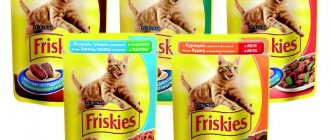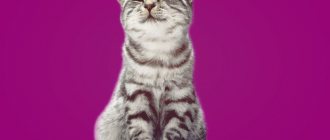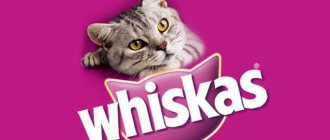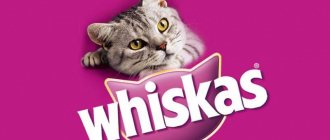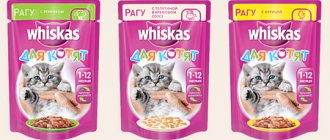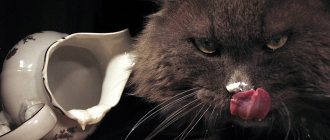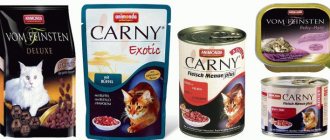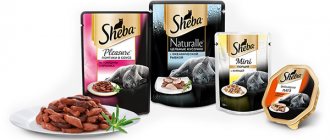Choosing the best way to feed a mustachioed pet falls on the shoulders of the person. Whiskas cat food is the most popular and affordable product intended for pets of all ages. The menu includes pillows filled with pate flavored with meat or fish, pieces in jelly, stew, and liquid cream soup. Wet and dry foods can be given at different times. You should not feed pads to cats that don't drink much. The amount of food in one meal is calculated based on the weight of the pet. Despite the fact that cats willingly eat Whiskas, veterinarians insist that it is harmful and causes serious problems with the urinary tract.
Ingredients of Whiskas: what is included?
Whiskas dry food is one of the well-known budget types of cat food. The country of origin is the USA, the Mars Corporation, which owns the brands Kitiket, Royal Canin, and Sheba. Whiskas products can be purchased in supermarkets or pet stores. The pack contains 350 and 800 g. Large packages are sold in 1.9 and 5 kg. The ingredients are indicated on the box, but the manufacturers do not specify the exact percentage of ingredients, and the presence of dyes and preservatives is not stated at all. It does not say which by-products are added to the feed. Accurate information can only be found on the website of the American manufacturer of dry food for cats. Composition of Whiskas feed:
- wheat flour;
- cereals;
- animal meal from poultry meat and bones;
- rice;
- plant protein extracts;
- offal;
- animal fat;
- sunflower oil;
- Brewer's yeast;
- vegetable pulp, mainly carrots and beets;
- vitamins and minerals;
- taurine
Veterinarians warn that cheap dry Whiskas contains very little fiber, which is necessary for a cat’s quality digestion, so for regular feeding it is better to choose premium food.
Disadvantages: addictive
Another significant drawback of Whiskas is that cats quickly get used to it. It seems so tasty to them that the animals refuse other food. Owners who decide to switch their cats to premium and super-premium ready-made food are faced with difficulties. Higher quality brands contain significantly lower amounts of flavorings and flavorings that are considered harmful. Accordingly, they are less attractive to the animal. But still, usually one or two days are enough for cats to try new food.
Whiskas for kittens, reviews of which are generally positive, as well as a product for adults and older animals occupy a significant share of the Russian market. But more and more often, owners are asking the question: do prepared foods harm the health of their pets? We can advise one thing: pay attention not only to the price, but also to the composition.
Feed lines
For animals that have undergone sterilization and castration, the manufacturer has provided special food.
Whiskas food is produced for furry pets of all ages. From 1 year old, cats can be given crunchy pads with fillings. The menu includes pate with chicken, beef, lamb, tuna, rabbit, and vegetables. The production of certain types of pads has been launched especially for cats over 8 years old. A pregnant cat should not be given economy class food; it is recommended to choose good cat food, for example, Royal Canin, which is also included in the Mars asset. “Whiskas” for kittens is a bag with pads to which milk, turkey or chicken and carrots are added, as well as wet food in the form of jelly or pate. Diet variety for adult cats:
- Special indoor. Low-calorie composition for domestic cats at risk of obesity.
- pH control. Designed for sterilized or neutered cats.
- Hairball. Cleanses the gastrointestinal tract of long-haired cats from hairballs.
- Sensitive. Useful for cats with sensitive or diseased digestive tracts, hypoallergenic.
- Duo treats. It is a fortified treat for cats with chicken, salmon, turkey, beef and cheese.
Types of factory food
The owner can choose dry or wet food for his mustache.
The manufacturer made sure that each owner could choose a diet based on the taste of the pet. There is dry food in the form of pads and wet food. Feeds differ in their water content. The pads help keep your pet's teeth and gums healthy. You cannot mix two forms of the product during one meal.
Dry food
Most of the protein in dry food is of plant origin. These foods contain a small percentage of fiber and moisture. The wheat flour in the composition is poorly absorbed by pets, causing allergies. If the owner decides to feed the pet with pads, you need to make sure that the cat drinks a lot, and if necessary, water it yourself. According to reviews from veterinarians and cat owners, dry food is harmful to cats, causing damage to the urinary tract. The naturalness of the food is low, it contains flavoring additives, but this is not written on the pack. Cats love crispy “crinkles”, and ill-informed owners decide to continue buying pads, not suspecting that the consequences for the health of their pets will be sad. A bag of dry “Whiskas” or “Kiteket” should not be left open to air, and if the food has evaporated, it is better to take a new one.
Cat owners and veterinarians note that it is very difficult to wean an adult pet from eating “drying”, and in many cases the cat does not eat natural food at all and requires a pad.
Wet food
Wet food is available in the form of a pate.
Soft food is packaged in small packages - 100 gram pouches. Inside there are pieces of meat in jelly or sauce. Meat content is 4%, the rest is by-products. The composition is enriched with vitamin E, zinc, phosphorus, taurine. Wet food is easier to digest and does not require strict drinking regimen. An opened package should be stored in the refrigerator for no more than a day. Whiskas for kittens contains calcium, which is good for bones, and Omega-3 fatty acids for caring for the fur of little fluffies. Wet Whiskas in bags:
- cream soup;
- jelly;
- stew;
- pates.
Whiskas
Overall food rating out of 55 possible points, including bonuses and penalties
Overall food rating out of 55 possible points, including bonuses and penalties
Overall food rating out of 55 possible points, including bonuses and penalties
Overall food rating out of 55 possible points, including bonuses and penalties
Overall food rating out of 55 possible points, including bonuses and penalties
Overall food rating out of 55 possible points, including bonuses and penalties
Overall food rating out of 55 possible points, including bonuses and penalties
Overall food rating out of 55 possible points, including bonuses and penalties
Overall food rating out of 55 possible points, including bonuses and penalties
Overall food rating out of 55 possible points, including bonuses and penalties
Overall food rating out of 55 possible points, including bonuses and penalties
Canned and dry cat food under the Whiskas brand is produced by the American corporation Mars, one of the world's largest food manufacturers. The company is headquartered in Virginia and has factories throughout the world.
Feeding standards
Until the kitten reaches 12 months of age, it should only be given kitten food.
To determine the daily and single dose, you need to know the weight of the animal. The norms are calculated to cover all the nutritional needs of the cat, but Whiskas is not a complete food in composition, so the portions are larger than those of premium foods. With a mixed diet, dry and wet foods are divided into several meals. The box or packaging contains information about the amount of food calculated for the pet's weight. The norm can be adjusted based on the needs of the pet. When feeding dry food with meat or fish, you need to make sure that the amount of water you drink is three times the serving of pads. One-time standard factory food for the weight of an adult pet
| Cat weight, kg | Calories per day | Dry form, gram | Wet, gram |
| 2—3 | 170 | 45 | 200 |
| 4—5 | 250 | 55 | 250 |
| 5—8 | 300 | 65 | 300 |
Brand Features
Why is Whiskas food so popular? Reviews say that this product is bought by owners who love their cats and want to please them with something tasty. Indeed, in the line you can find such mouth-watering items as “Stew with chicken in creamy sauce” or “Jelly with turkey and vegetables.”
Dry food is packaged in bright cardboard boxes that are easy to open and close. Wet food is sold in cans or bags in portions. You just need to open the package and put the delicious pieces into a bowl. You should know that when using dry food, the cat must have constant access to fresh water. For normal digestion, the animal must drink 3 times more water than it ate food.
Dry food is convenient to use, as it can be on the plate all day long. The contents of jelly and stew bags cannot be stored in the air for a long time.
Benefits and harms of economical food for cats
Fluffies are usually delighted with such food and gobble it up with pleasure.
The main advantage of Whiskas is its availability and low price per pack. It is very tasty for cats and they eat it with pleasure, quickly getting full. The owner does not need to spend time preparing food for the pet or developing its diet. Dry food lasts a long time. A wide range will allow you to choose a diet for pets with special needs.
Disputes about the dangers and benefits of Whiskas continue constantly. Doctors believe that these products cannot provide a pet with a balanced diet, since they consist of plant proteins and contain very little meat. In addition, the abundance of food additives and dyes harms the cat’s gastrointestinal tract. The American Veterinary Association has obtained information that the food is made from poor quality by-products, meat from the corpses of killed or euthanized animals, so there is no talk of benefits. After regularly consuming Whiskas in their pads, many cats develop urolithiasis. Liquid cat food in pouches is less harmful, but expensive. Pets quickly get used to the food and refuse natural food, and it is impossible to combine homemade food with factory-made food.
Disadvantages: save on health
How good is Whiskas? Reviews indicate that all economy-class food is of rather low quality. It is worth noting that there are still cheap options on the market that are significantly inferior to Whiskas in terms of the content of nutrients. You should be especially careful when buying unknown brands and brands produced by retail chains. Always read the ingredients before purchasing!
Another disadvantage can be considered the high price for canned food, taking into account the high water content and far from ideal composition.
Reviews from professional breeders and veterinarians are not reassuring - low-quality food can cause numerous gastrointestinal diseases and allergies in cats. The animal's kidneys and liver are especially at risk. Veterinarians are increasingly citing cheap, low-quality food as the cause of urolithiasis. Trying to save money on your cat's food can have a detrimental effect on your pet's health and lead to its death. Do not forget that the animal must be regularly shown to the veterinarian and, if necessary, tests done.

